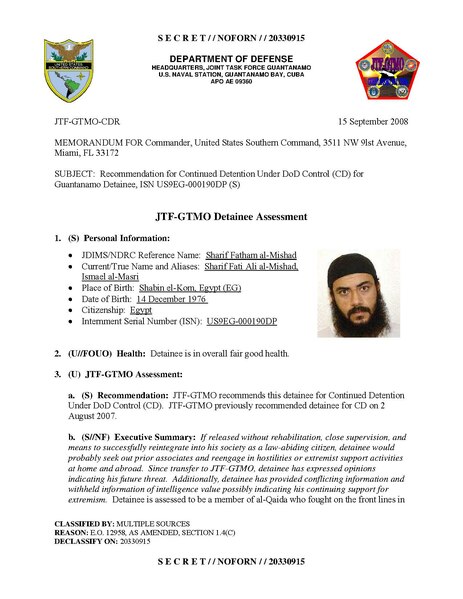The Houthis, the Saudi, Yemen and the history.
U.S. Navy Seizes Suspected Iranian Arms Shipment Bound for Yemen
A cache of weapons is assembled on the deck of the guided-missile destroyer USS Gravely (DDG 107). The weapons were seized from a stateless dhow which was intercepted by the Coastal Patrol ship USS Sirocco (PC 6) on March 28. US Navy Photo
USNI: Two U.S. Navy vessels seized a ship laden with illegal weapons in the Persian Gulf that were bound for Houthi fighters in Yemen, the service announced on Monday.
The stateless dhow was initially intercepted by the Cyclone-class patrol craft USS Sirocco (PC-6) on March 28 and the boarding team discovered 1,500 AK-47s automatic rifles, 200 RPG launchers and 21 .50-caliber machine guns in the hold that had been presumably shipped from Iran, according to the service.

200 RPG launchers as part of the seizure. US Navy Photo
Sirocco called in guided missile destroyer USS Gravely (DDG-107) for assistance in seizure and collected the weapons from the dhow, according to a statement from U.S. 5th Fleet.
“This seizure is the latest in a string of illicit weapons shipments assessed by the U.S. to have originated in Iran that were seized in the region by naval forces,” read a Monday statement from the service.
“The weapons are now in U.S. custody awaiting final disposition. The dhow and its crew were allowed to depart once the illicit weapons were seized.”
USS Sirocco (PC 6) assigned to Commander, Task Force (CTF) 55 during a bilateral exercise with the Iraqi Navy. US Navy Photo
The interdiction of the weapons is the third similar interception since late February by allied forces in the Persian Gulf.
“The Royal Australian Navy’s HMAS Darwin intercepted a dhow Feb. 27, confiscating nearly 2,000 AK-47 assault rifles, 100 rocket-propelled grenade launchers, 49 PKM general purpose machine guns, 39 PKM spare barrels and 20 60mm mortar tubes,” said the service.
“A March 20 seizure by the French Navy destroyer FS Provence yielded almost 2,000 AK-47 assault rifles, 64 Dragunov sniper rifles, nine anti-tank missiles and other associated equipment.”Sirocco is part of the forward-deployed Cyclone force based out of Bahrain and Gravely is attached to the Harry S. Truman Carrier Strike Group (CSG).
The following is the April 4, 2016 release on the seizure from U.S. 5th Fleet.
MANAMA, Bahrain (NNS) — For the third time in recent weeks, international naval forces operating in the waters of the Arabian Sea seized a shipment of illicit arms March 28, which the United States assessed originated in Iran and was likely bound for Houthi insurgents in Yemen.
The U.S. Navy Coastal Patrol ship USS Sirocco, operating as part of U.S. Naval Forces Central Command, intercepted and seized the shipment of weapons hidden aboard a small, stateless dhow. The illicit cargo included 1,500 AK-47s, 200 RPG launchers and 21 .50 caliber machine guns.
The seizure was supported by USS Gravely (DDG 107), which was directed to the scene by United States Naval Forces Central Command following the discovery of the weapons by Sirocco’s boarding team.
The weapons are now in U.S. custody awaiting final disposition. The dhow and its crew were allowed to depart once the illicit weapons were seized.
This seizure is the latest in a string of illicit weapons shipments assessed by the U.S. to have originated in Iran that were seized in the region by naval forces.
The Royal Australian Navy’s HMAS Darwin intercepted a dhow Feb. 27, confiscating nearly 2,000 AK-47 assault rifles, 100 rocket-propelled grenade launchers, 49 PKM general purpose machine guns, 39 PKM spare barrels and 20 60mm mortar tubes.
A March 20 seizure by the French Navy destroyer FS Provence yielded almost 2,000 AK-47 assault rifles, 64 Dragunov sniper rifles, nine anti-tank missiles and other associated equipment.
NAVCENT is responsible for approximately 2.5 million square miles of area including the Arabian Gulf, Red Sea, Gulf of Oman, parts of the Indian Ocean and 20 countries.
*****
Meanwhile, Congress does maintain a list of Iranian violations and is working to compile evidence that the Obama administration has in fact just lied to Congress.
*****
Congress Investigating Obama Admin Deception on Iran Nuke Deal
FreeBeacon: Congress is investigating whether the Obama administration misled lawmakers last summer about the extent of concessions granted to Iran under the nuclear deal, as well as if administration officials have been quietly rewriting the deal’s terms in the aftermath of the agreement, according to sources and a formal notice sent to the State Department.
The concerns come after statements from top officials last week suggesting that Iran is set to receive greater weapons and sanctions relief, moves that the administration had promised Congress would never take place as White House officials promoted the deal last summer.
“When multiple officials—including Secretary Kerry, Secretary Lew, and Ambassador Mull—testify in front of Members of Congress, we are inclined to believe them,” Rep. Mike Pompeo (R., Kan.) told the Washington Free Beacon.
“However, the gap between their promises on the Iran nuclear deal and today’s scary reality continues to widen. We are now trying to determine whether this was intentional deception on the part of the administration or new levels of disturbing acquiescence to the Iranians,” Pompeo said.
Congress is believed to be investigating what insiders described to the Free Beacon as a range of areas in which administration officials may have understated the breadth of concessions made to the Islamic Republic when trying to persuade lawmakers to sign off on the final deal.
Multiple disputes have surfaced in the last week.
In one dispute, congressional leaders are concerned that the administration no longer considers recent Iranian ballistic missile tests a “violation” of United Nations Security Council Resolution 2231, which codifies the nuclear deal.
Top administration officials including Secretary of State John Kerry vowed to Congress that Iran would be legally prohibited from carrying out ballistic missile tests under the resolution.
Samantha Power, the U.S. ambassador to the U.N., shifted course last week, refusing to call recent Iranian launches a “violation” in a letter she signed criticizing those launches.
A second dispute centers around recent statements from Treasury Department officials suggesting that the administration is now set to grant Iran non-nuclear sanctions relief, including indirect access to the U.S. financial system, weeks after top Iranian officials began demanding this type of sanctions relief.
Top administration figures, including Treasury Secretary Jack Lew, had promised Congress that years-old restrictions barring Iran from accessing the U.S. financial system in any way would remain in place even after the nuclear deal.
But new concerns have raised alarm bells among lawmakers, who fear that the administration will ease longstanding restrictions on Iran.
Kerry “and other administration officials assured the American people and Congress that UNSCR 2231 still allowed the U.S. to respond to dangerous actions, like these, from the Iranians,” Reps. Pompeo, Peter Roskam (R., Ill.), and Lee Zeldin (R., N.Y.) wrote in a letter last week to the State Department.
“While many lawmakers, ourselves included, are certain that Iran’s latest tests violate UNSCR 2231, your decision to cease labeling the launches a violation is alarming,” they wrote. “We are troubled by reports that the administration is stifling voices within its ranks for stronger action against Iran—putting the JCPOA and political legacy above the safety and security of the American people.”
The United States backed down in recent days from its claim that the ballistic missile tests violate the deal. The United States now says that they are “inconsistent with” promises made by Iran while the deal was being negotiated.
“This seeming American refusal to name these Iranian tests as violation is in direct conflict the administration’s earlier commitments,” the lawmakers wrote.
As the nuclear deal was being negotiated, Kerry informed Congress that, under the deal, Iran would be “restrained from any … work on missiles.” Other administration officials at the time made also clear that such tests “would violate” the agreement.
The administration has recalibrated its stance in recent days in the wake of several recent ballistic missile tests by Iran. Officials are no longer claiming that these tests violate the deal.
“In opposition to this testimony, administration officials have recently told the press that UNSCR 22231 was ‘drafted/structured in a way to appeal to Iran’s sensitivities,’” the lawmakers write.
Mark Dubowitz, executive director for the Foundation For Defense of Democracies (FDD), told the Free Beacon that the administration is redefining the terms of the nuclear deal.
“The Obama administration is involved in yet another sleight of hand on sanctions relief as well as the status of U.N. missile sanctions,” Dubowitz sai. “This is very familiar to those who tracked the Iran nuclear talks and recall the many ways in which broken commitments were justified and redlines were abandoned.”
Iranian allies on the U.N. Security Council, mainly Russia, have defended the missile tests, arguing that resolution 2231 has only “called upon” Iran to refrain from these tests.
Russian Ambassador Vitaly Churkin recently stated that the newest U.N. resolution governing the nuclear agreement only suggests that Iran stop test firing missiles.
“A call is different from a ban so legally you cannot violate a call, you can comply with a call or you can ignore the call, but you cannot violate a call,” Churkin was quoted as saying. “The legal distinction is there.”
Congressional critics have dismissed the argument and are pressing on the Obama administration to stand up to Iran’s defenders.
“The Kremlin’s absurd legal argument after Iran’s March tests that ‘legally you cannot violate a call’ would essentially allow the Iranian regime to do anything it wants to further develop its ballistic missile program,” the lawmakers wrote in their letter.
“Russia’s refusal to punish Iran, combined with its veto and China’s veto on the Security Council, will continue to prevent any real international effort to respond to Iranian infractions.”
Meanwhile, Iranian officials have said in recent days that they are preparing to expand the country’s ballistic missile program.
“We have always said we will continue with developing our defense capacity and the defense equipment has nothing to do with chemical weapons,” Iranian Foreign Minister Javad Zarif stated on Twitter. “The missiles are only for defensive purposes and we have not invaded any country, neither we will do so in the future.”
Other Iranian officials have also said the ballistic missile tests have nothing to do with the nuclear agreement.
A bipartisan delegation of lawmakers in Congress has expressed opposition to an Obama administration plan to grant Iran sanctions relief outside the purview of the nuclear deal.
This new relief is reported to include access to the U.S. dollar and American financial markets. Lawmakers have expressed anger over the proposal, citing past comments from administration officials who claimed this would never take place under the deal.



